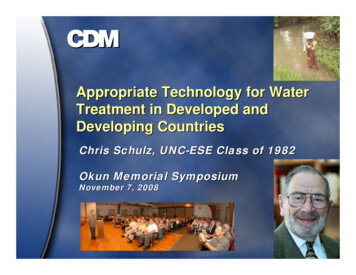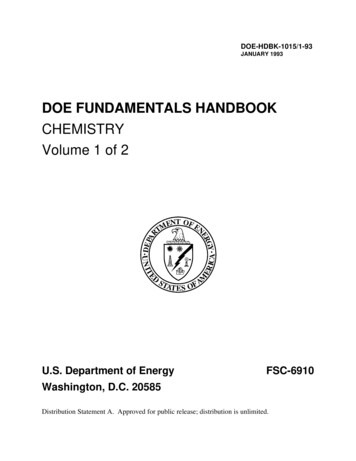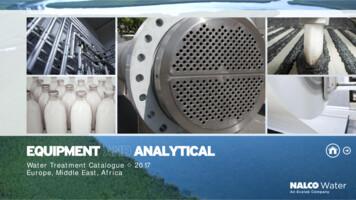
Transcription
Appropriate Technology for WaterTreatment in Developed andDeveloping CountriesChris Schulz, UNC-ESE Class of 1982Okun Memorial SymposiumNovember 7, 2008
Presentation TopicsXXXXXWater treatment milestones since 1982Defining appropriate technology for watertreatmentAdvanced water treatment processes fordeveloped countriesBasic water treatment processes fordeveloping countriesCDM Engineers Without Borders
My preparationReview Schulz/OkunbookX Email request to friendsand colleaguesX Google keyword searchX UNC photo albumX
1982 - UNC Graduation/Hired byWorld Bank1991 – Water for PeopleBegan2000 – Engineers WithoutBorders Began2000 - Patent on UV Disinfection ofCrypto2000‐20082007 – AP Article onPhameceuticals in Drinking Water1980-1990 UNInternational Water &Sanitation Decade1990sUSEPA DW Reg’s1993 – Milwaukee Crypto Outbreak1989 - SWTR1998 - IESWTR1999 - Stage 1 DBPR2000 – LT2ESWTR2006 – LT2ESWTR/Stage 2 DBPR1980s1986 -19861st MFMembraneSystem– Hiredby CDMInstalled in Australia1984 - Schulz/Okun Book2002 - UN MillenniumProject Commissioned2004 – USA Mellennium ChallengeCorporation Established
Projected Global Growth Rates AcrossWater/Wastewater Technology SpectrumWater Treatment Markets - CAGR 2005-201125%20%15%10%5%0%MBRMF/UFMembranesUV Treat.WW Treat.& ReuseIonExchangeSource: GE Water Presentation, CDM Water Forum, 2007RODW & PWOzoneTreat. Equip. DisinfectionActivatedCarbon forDW
UN Mellenium DevelopmentGoal for Water and SanitationGoal:Cut in half by 2015, proportion of peoplewithout sustainable access to safe drinkingwater and basic sanitationBenefits: 1 investment earns economic return of 3-4X 10% global reduction of diarrheal episodesX 7.3 billion health-related cost avoidanceX 750 million global value of adult workingdays due to less illnessUSA Mellenium Challenge Corporation: 530 million invested in 7 partner countries thru 2008X
Defining Appropriate Technology (AT)Working Definition“Design practice, whether it be in adeveloped or developing country,should strive to optimize the totalinvestment of available capital,material and human resources,recognizing the limited resources ofeach that may exist.”Daniel Okun, 1984
Defining Appropriate Technology (AT)Economic ConsiderationsDeveloped Countries:“An investment of about 600,000 in capitalequipment would be warranted to replacean around-the-clock attendant in USA basedupon total cost of 20,000 per year for eachof four persons, 15-year life of equipmentand 10% interest .”Developing Countries:“ 20,000 might be the maximum investmentwarranted, based upon a wage of 1,000 peryear, 10-year equipment life and 20%interest.”Daniel Okun, 1984
Common attributes of water treatmenttechnologies in developed countriesXXXXXProprietary equipment,chemicals and supportservicesHighly automated andinstrumented plantHigh-rate processesMulti-stage advancedtreatment barriersNew focus onsustainability (triplebottom line)
Common attributes of sustainable watertreatment projects in developing countriesXXXXXXXLabor-intensive solutionsReliance on hydraulicsolutionsLocally producedequipmentIndigenous chemicalsLow-rate processesBasic treatmentprocessesManual operation,monitoring and control
Typical reasons for widespread use of“IT” in developing countriesExpatriate engineers only familiar with highlymechanized treatment processes used backhomeX Utilitymanager desires “only the best” whichSeedsof Change:erroneously EngineersWithoutmeansBordersthe latest or most complextechnology WaterFor People and Water Corps Universityof contractorsColorado Curriculumon EngineeringforX Turnkeytypicallyselect capitalDevelopingCountriesintensivedesigns because of greater profitabilityX Professors tend to focus on most advancedtechnology so students are not exposed totechnology appropriate to developing countriesX
Advanced Water Treatment Processesin Developed CountriesCoagulantPowder Activated psReject Solids to SewerConventional leWaterRapidMixFlocculationSedimentationSettled psReject Solids to SewerALTERNATIVE BAdvanced Ozone/BAC Treatment
Advanced Water Treatment Processesin Developed CountriesCoagulantPowder Activated dMixAdvanced Water Treatment arwellMembranesOzoneand Ozone/AOPXUV Disinfection and UV/AOP Reject Solids to SewerXHigh-RateClarificationDirectMembrane TreatmentXIon Exchange Processes (MIEX)XBiological FiltrationXMF/UF Pressure ed MembranesSedimentation MembranesOzoneBiologicalContactFiltersOn-Site Chlorine/Hypo GenerationPotableWaterHighServicePumpsReject Solids to SewerClearwellAdvanced Membrane/Ozone/BAC Treatment
High-Rate Clarification(Superpulsator, DAF, Actiflo)XXXXXEffective removal ofturbidity, color andTOC5 to 20 times smallerfootprint than HFsedimentation processesRetrofit vs. physicalexpansion tradeoffs
Ozone Disinfection/OxidationXXXXPowerful disinfectant(Giardia, Crypto, virus)No chlorinated DBPsMultiple oxidation benefits(T&O, Fe/Mn, Color,pesticides, PPCPs)May require controlstrategies for removingBDOC and bromateNew technologies forimproved G/L mixing andMTE807060Concentration (ug/l)XOzone /TTHMoPost-CL2Pre-CL2/ b-98Apr-98Jun-98DateLanier WTP, Gwinnett County, GAJul-98
UV Disinfection/AOPCost-effective forGiardia/Cryptodisinfection (but notvirus)X BAT for unfilteredsuppliesX BAT for nitrosaminesremoval (NDMA)X UV/AOP effective forT&O removal butrequires:X Peroxide quenchingsystem10.0DISINFECTIONT&OEVENT DISINFECTION1.00.100.011050.001Jan Feb Mar Apr May Jun Jul Aug Sep Oct Nov DecPeroxide(mg/L)X 10-30 times more powerUV Power Requirements (Kwh/1.000 gal)X
Low-Pressure MF/UF MembranesXXXXXXXXLow turbidity ( 0.05 NTU) 4-log Giardia andCryptosporidium removalLess reliance on pretreatmentSmaller footprintProprietary processFully automated processRequires piloting to determineflux rates and foulingcharacteristicsCost-competitive withconventional treatment
Source Selection and TreatmentRequirements in Developing CountriesBasic Water Treatment Processes:1. Groundwater:X Pretreatment for Sediment RemovalPumping & Possibly ChlorinationX Locally Available Chemicals (Alum,2,IronLakesor Streams:Salts,Lime, Hypochlorite)Slow Sand FiltrationX Solution-Type Chemical Feeders,Saturators 3. Rivers:Pretreatment and SSFX Hydraulic Mixing and Flocculation4. Turbid Rivers:ChlorineHorizontal-Flow SedimentationConventional TreatmentX Rapid Filters with rRapidMixX FlocculationSlow vicePumpsReject Solids to Sewer
Hydraulic Mixing and FlocculationXXXXXXMixing achieved by headloss (not horsepower)Weirs/flumes can providenear instantaneous mixingNo imported equipmentSimplified O&MTapered flocculationwithout flow shortcircuitingMixing energy dependenton plant flow
Slow Sand FiltersXXXXXXNo power or chemicalsSignificant bacteria reduction (3-4 log)Built with local labor and materialsCleaned by unskilled laborRequires large land area (FLR 0.1 gpm/sft)Limited to turbidity 50 NTU
Kiosk Membrane TreatmentSystem (SkyJuice Foundation)XXXXXXXTreats turbid water sources (500NTU) without chemicalsSignificant protozoa/bacteriaremoval (3-4 log)Requires only 1 m of head foroperationManually backflushedCan produce 10,000liter/day 2,000/unitAT for entrepreneurialwater vendors
Kiosk Membrane Treatment System(SkyJuice Foundation)
HWTS Ceramic Filter Systems(Potters for Peace—Ron Rivera)Colloidal silver-enhancedceramic water purifierX 30 filter factories worldwide“There is now conclusive evidence that simple, acceptable, lowcostinterventionsat thehouseholdfiltersserving1.5 level are capable ofX 300,000dramaticallyimproving the microbial quality of household watermillion peopleands reducing the attendant risk of diarrheal disease and death.”X Profitable microenterprisesMark Sobsey, UNCWHO Report, 2002X Produces 1-3 liters/hrX 10-15/unit with plasticreceptacle and tapX
CDM EngineersWithout BordersFall 2007—Launched PartnershipProgramX EWB Local Chapter RepresentativesXXXX 27 chapters to dateActs as liaison to local CDM office,contact pointFunding set aside for employeegrantsXXXUp to 2,500 per employeeCovers travel/professional costsNot intended for project fundraising
Here’s to the WRE Class of 1982!SCHULZ/OKUN BOOK DOWNLOADED es.pdf
Jul 06, 2013 · Advanced Water Treatment Processes in Developed Countries Advanced Ozone/BAC Treatment Rapid Mix Flocculation Sedimentation Biological Filters Settled Water Ozone Reject Solids to Sewer Clearwell High Service Pumps Chlorine Ammonia ALTERNATIVE B Raw Water Potable WaterWater Coagulant H 2










